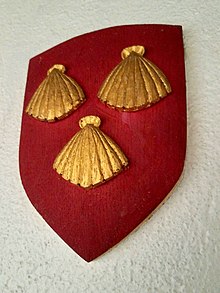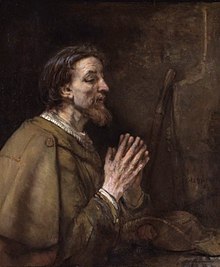
Santiago de Compostela, simply Santiago, or Compostela, is the capital of the autonomous community of Galicia, in northwestern Spain. The city has its origin in the shrine of Saint James the Great, now the Cathedral of Santiago de Compostela, as the destination of the Way of St. James, a leading Catholic pilgrimage route since the 9th century. In 1985, the city's Old Town was designated a UNESCO World Heritage Site.

The Kingdom of Asturias was a kingdom in the Iberian Peninsula founded by the Visigothic nobleman Pelagius. It was the first Christian political entity established after the Umayyad conquest of Visigothic Hispania in 711. In 718 or 722, Pelagius defeated an Umayyad army at the Battle of Covadonga, in what is usually regarded as the beginning of the Reconquista.
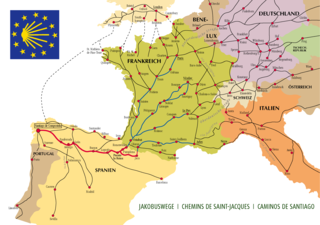
The Camino de Santiago, or in English the Way of St. James, is a network of pilgrims' ways or pilgrimages leading to the shrine of the apostle James in the cathedral of Santiago de Compostela in Galicia in northwestern Spain, where tradition holds that the remains of the apostle are buried.

The Santiago de Compostela Arch cathedral Basilica is part of the Metropolitan Archdiocese of Santiago de Compostela and is an integral component of the Santiago de Compostela World Heritage Site in Galicia, Spain. The cathedral is the reputed burial place of Saint James the Great, one of the apostles of Jesus Christ. It is also among the remaining churches in the world built over the tomb of an apostle, the other ones being St Peter's Basilica in Vatican City, St Thomas Cathedral Basilica in Chennai, India and Basilica of St. John in Izmir, Turkey.
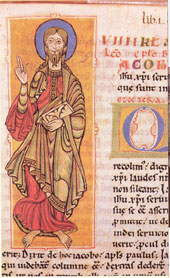
The Codex Calixtinus is a manuscript that is the main witness for the 12th-century Liber Sancti Jacobi, a pseudepigraph attributed to Pope Calixtus II. The principal author or compiler of the Liber is thus referred to as "Pseudo-Calixtus", but is often identified with the French scholar Aymeric Picaud. Its most likely period of compilation is 1138–1145.

The Iberian Peninsula, where Galicia is located, has been inhabited for at least 500,000 years, first by Neanderthals and then by modern humans. From about 4500 BC, it was inhabited by a megalithic culture, which entered the Bronze Age about 1500 BC. These people would become the Gallaeci, and they would be conquered by the Roman Empire in the first and second centuries AD. As the Roman Empire declined, Galicia would be conquered and ruled by various Germanic tribes, notably the Suebi and Visigoths, until the 9th century. Then the Muslim conquest of Iberia reached Galicia, although they never quite controlled the area.
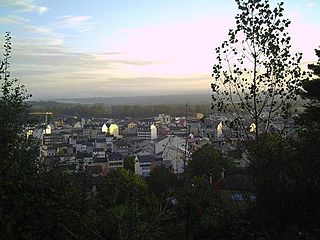
Sarria is a municipality in the province of Lugo, in the autonomous community of Galicia, northwestern Spain. It belongs to the comarca of Sarria. Sarria is the most populous town on the French Way in Galicia, with 13,700 inhabitants and the major is Carmen José Lòpez. It is head of the region and the most popular starting point for the Camino de Santiago; many pilgrims choose Sarria because the distance from this point to Santiago allows them to cover the necessary kilometers to reach the Compostela. King Alfonso IX of León died in Sarria in 1230 while making a pilgrimage to Santiago de Compostela.
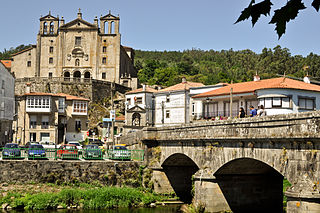
Padrón is a concello in the Province of A Coruña, in Galicia (Spain) within the comarca of O Sar. It covers an area of 48.4 km2, is 95 km from A Coruña and 23km from Santiago de Compostela. As of 2009, had a population of 8968 according to the INE. Padrón is divided into five parishes:

The Battle of Clavijo is a mythical battle, believed for centuries to be historical, which became a popular theme of Spanish traditions regarding the Christian expulsion of the Muslims. Stories about the battle first arose centuries after it allegedly occurred; according to these stories, it was fought near Clavijo between Christians led by Ramiro I of Asturias and Muslims led by the Emir of Córdoba.The Diccionario de historia de España (1968) says: "To a serious historian, the existence of the Battle of Clavijo is not even a topic of discussion."
Juan de Ortega, better known as Saint John the Hermit, was a Spanish priest and hermit. A disciple of Dominic de la Calzada, he is best known for repairing roads and bridges along the Camino de Santiago. He also built a hospice as a shelter for pilgrims and founded the monastery of San Juan de Ortega.

Christianity has a strong tradition of pilgrimages, both to sites relevant to the New Testament narrative and to sites associated with later saints or miracles.

The Hostal dos Reis Católicos, also called the Hostal de Los Reyes Católicos or Parador de Santiago de Compostela, is a five-star Parador hotel, located in the Praza do Obradoiro of Santiago de Compostela, Spain. It is widely considered one of the oldest continuously operating hotels in the world, and has also been called the "most beautiful hotel in Europe".

Saint James the Moor-slayer is the name given to the representation of the apostle James the Great, as a legendary, miraculous figure who appeared at the also legendary Battle of Clavijo, helping the Christians conquer the Muslim Moors.
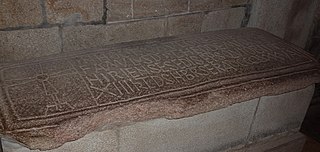
Theodemir or Theodomar, was a bishop of Iria, in Galicia.

Pico Sacro is a summit in the central Galician Massif and the municipality of Boqueixón. In antiquity it was known as Mount Ilicino, and features a hermitage, a cave, the remains of a medieval castle and a triangulation station. The mountain rises 530 meters (1,740 ft) and is known for its unique shape and a legend about the Apostle James. A deep and narrow cave sits just below the peak, and legend places a dragon there protecting one of the entrances to hell.
Pelagius was a hermit or anchorite who lived in Solovio in the Libredón forest in 813 AD.
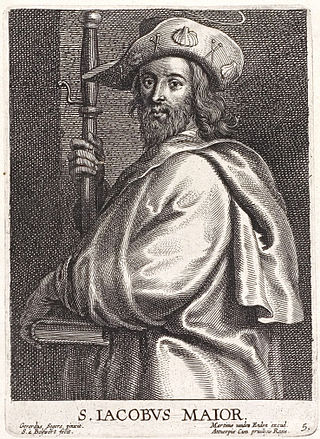
The Feast of Saint James, also known as Saint James' Day, is a commemoration of the apostle James the Great celebrated on July 25 of the liturgical calendars of the Roman Catholic church and of the Anglican, Lutheran and some other Protestant churches. The Orthodox Christian liturgical calendar commemorates James on April 30.

Libredón was a forest, sometimes also described as a mountain, near Santiago de Compostela that according to legend, is where the body of Saint James was laid to rest. There is a belief that the forest was located at the Oak grove of Santa Susana, a hill in Santiago de Compostela that is part of the Parque da Alameda de Santiago de Compostela.

Queen Lupa is a character from Galician mythology. She is mentioned in both the Codex Calixtinus and the Golden Legend.


